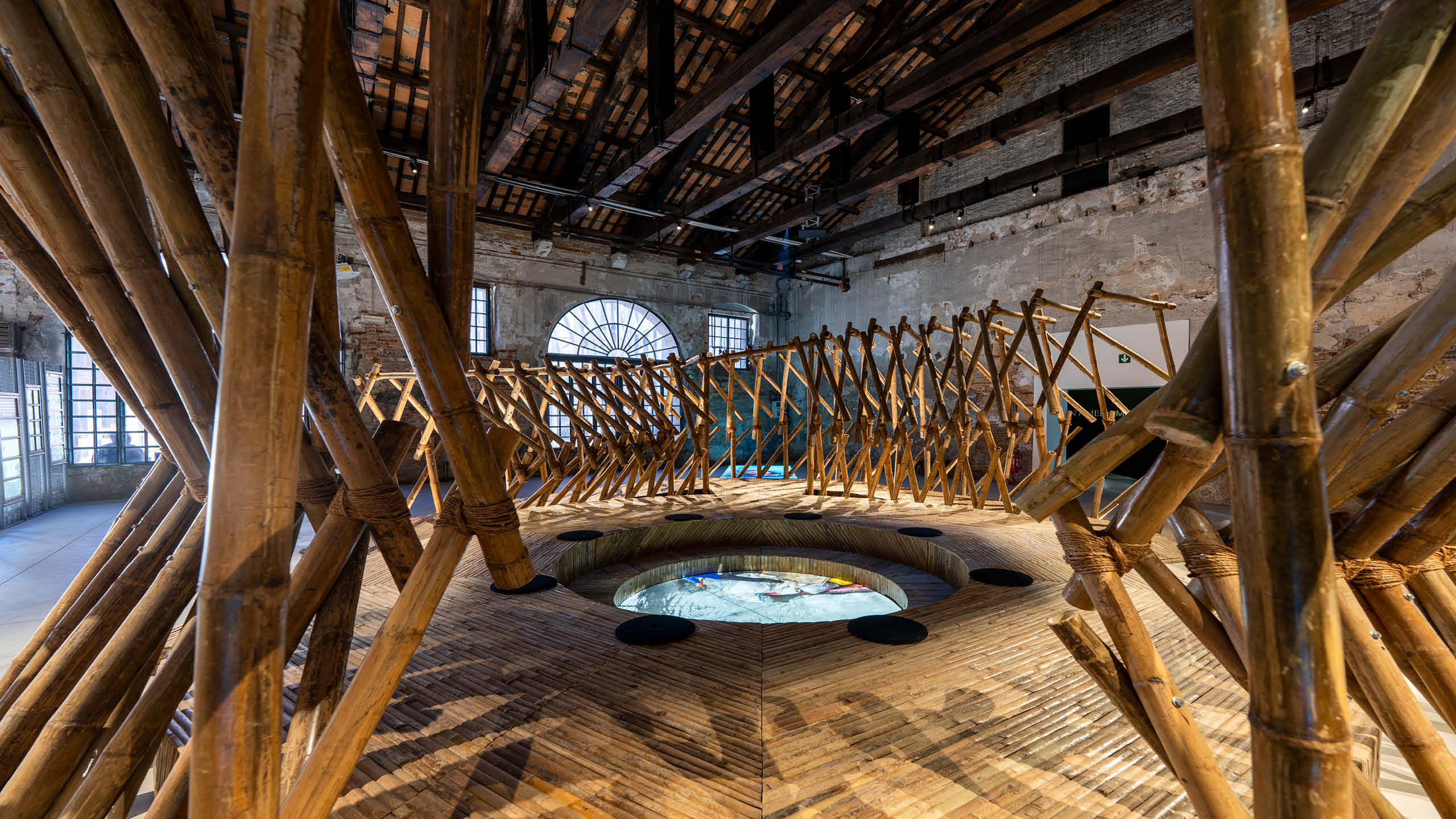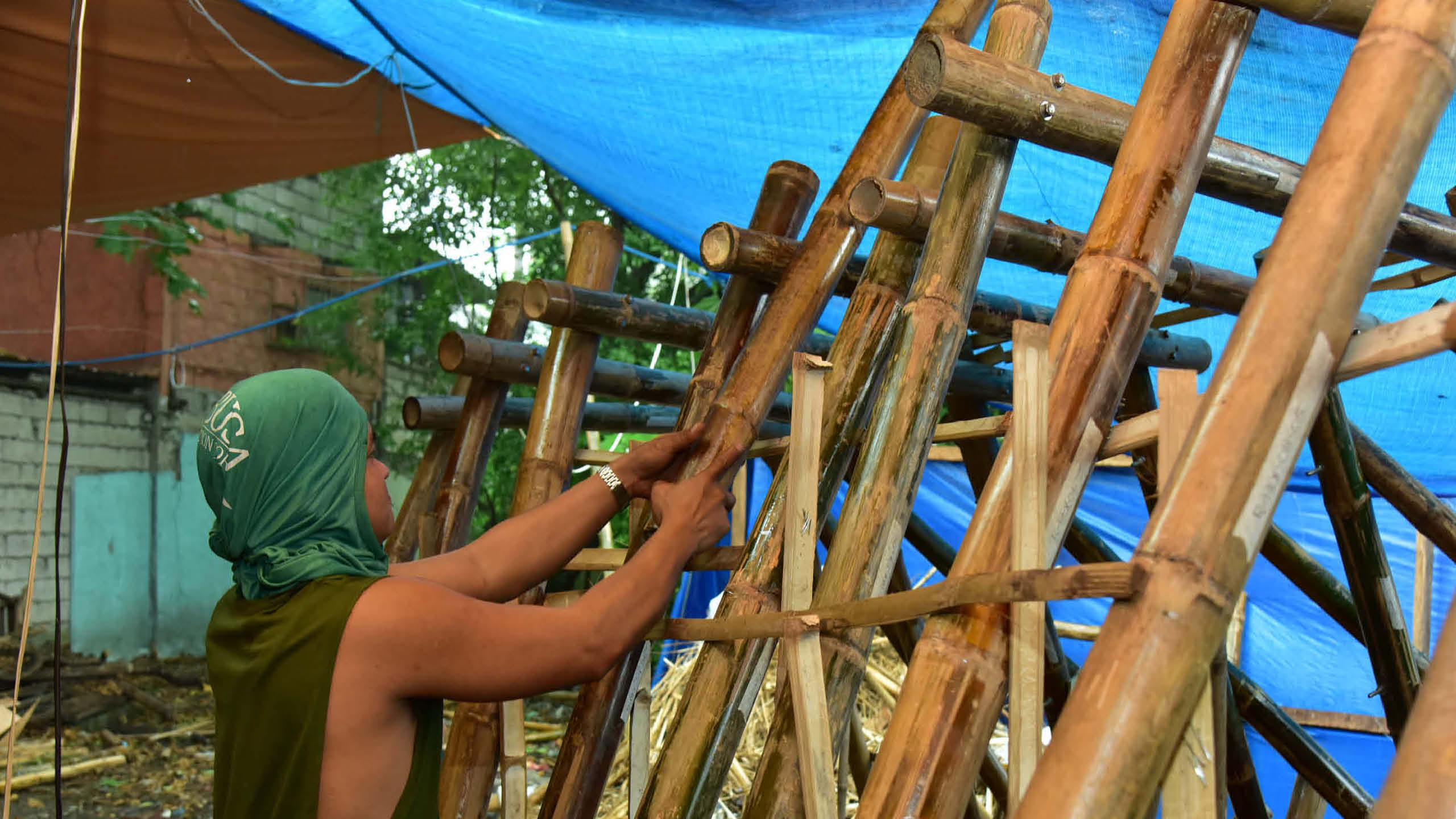
The Philippine Pavilion Addresses Environmental Concerns of Metro Manila Estuaries at The Venice Architecture Biennale 2023
Last May 18, 2023, during the pre-opening of the 18th International Architecture Exhibition of La Biennale di Venezia, the Philippines opened its National Pavilion featuring Tripa de Gallina: Guts of Estuary by The Architecture Collective (TAC) which is composed of Bien Alvarez, Matthew Gan, Architect Lyle La Madrid, Noel Narciso, and Arnold Rañada and co-curated by Architect Choie Funk and Sam Domingo. The pavilion is located at the Arsenale—a main exhibition space in La Biennale alongside other national pavilions.

(L-R) Arnold Rañada, Matthew Gan, Bien Alvarez, Ar. Lyle La Madrid, Honorary Consul in Veneto Atty. Giorgia De Biasi, His Excellency Ambassador-designate Nathaniel Imperial, Co-curators Sam Domingo and Ar. Choie Y. Funk, Heart Evangelista-Escudero, Senator Chiz Escudero, Consul General Elmer Cato of PCG Milan, and Noel Narciso. | Photo by Lorenzo Busi
Tripa de Gallina (translated as “guts of the rooster”) is the longest estuary in Metro Manila, and serves as a tributary among larger bodies of water in the area. Over the centuries, the estuary has been functioning mainly as a channel to mitigate flooding and drain water from various parts of the city, but has eventually become congested with residents and subsequently, polluted with trash. The exhibition addresses the unsustainable environmental and social circumstances in the area and proposes an architectural solution that highlights the significance of empathy, collaboration, reflection, and gathering.
Creating Solutions by Understanding the Context of the Problem
In an interview with BluPrint, Architect Funk explained that the concept started as a school activity. According to her, part of the investigation was to identify the context of the problem so that when they design something, it will respond to that. She highlighted that no solutions should be made without understanding the context.

Barangay 739 in Manila, featuring the houses fronting the site. The photo shows one of the two bridges which the pavilion drew inspiration from. | Photo by Michael Angelo Reyes, Matthew Jonathan Gan, and Bien Victor Alvarez
After careful consideration, the team decided to address the problem of solid waste management and solid waste mismanagement because people have been throwing garbage into the water. They tried to understand why that happened and why it persisted all these years. The only solution there was was to clean it. For them, this was not enough. They had to go deeper and seek the help of a social worker to further understand the problem and how they can help the people within the community.
The understanding of the situation led the team to believe that there is a need for people to talk some more. The team saw the two bridges in the area that serve as a place for people to hangout, sell goods, and at the same time a passageway for the residents. This highlights the lack of public spaces where people can gather as a community in Metro Manila.

The estero (creek) has been physically segmented in various portions through the use of steel, mesh and framing. Different barangays would assign cleaners to each segment. | Photo by Michael Angelo Reyes, Matthew Jonathan Gan, and Bien Victor Alvarez

Testing the buoyancy of the pavilion platforms, as part of the Global Summer School Program – Manila | Photo by Michael Angelo Reyes, Matthew Jonathan Gan, and Bien Victor Alvarez
In 2020, Manila was the densest city in the world with 46,178 persons per square kilometer. Because of this, there’s not enough space for easement for people to live comfortably. For the residents of the community, however, the lack of public spaces is the least of their concerns. Instead of worrying about having a communal space everyone can use, they would rather think about how they can survive day-to-day. “We felt that that is the added difficulty here. Do they care enough about the environment when all they really want is to live one day at a time. They don’t even know that they are [being] deprived of environmental justice,” said Funk.

Looking into these circumstances, the curators and the exhibitors asked themselves what kind of architecture they are learning and who they build for. With this, Funk shared: “Architecture has to be in the service of building communities by providing spaces and conditions to encourage dialogues.” The people might come up with solutions that they will talk about and they will agree as a community. Funk added that there is a possibility for sustainability and actual carrying out of the solutions. The architects can provide a space and suggest. “But for it to actually work, the community has to be engaged and allowed to participate and decide on a future. We will help them realize: you have it in you to forge this future for yourself,” she said.

Moreover, co-curator Sam highlighted that solid waste mismanagement is one of the apparent manifestations of the disconnect that we have in relationships (between one another, the environment, and the non-living things). With the lack of public space, the solid waste management in many communities near the estuaries has been aggravated by the pandemic because people didn’t know where to put their trash so they just threw it into the river.
In response to this problem, the TAC, the curators, and other groups involved in the project used public space acupuncture. “That public space acupuncture necessitates a lot of ground work, community engagement, and social development work. This is not the end product of the process because we will continue engaging with the community,” Sam explained.
Re-establishing Connections Between Human and The Environment

The featured exhibition offers a diagnosis of the water’s condition and a prognosis of the people’s future. In a procedure of modular urban acupuncture materialized by a bamboo structure that serves as a place of gathering and investigation, the Pavilion inspects the estuary’s guts: a flawed ecology of humans, waters, and dregs. It serves as a buoy for this mesh to be carefully unraveled and sustainable mended through collaborative action in the name of resilience.

Sam explained that the windows in the installation provide a screen on which moving archival materials play out, testifying to a tenacious urban struggle in history. The narrative leads to the center when an immersive audio-visual encounter with the estero lurks day and night, where both videos were directed by filmmaker and educator Jag Garcia. From the groundwork, a lively prospect of the state of the entire ecology is imagined through the structure’s ethnographic projections.



The bamboo structure stems from the intention of the members of TAC, a group of independent practitioners from the fields of architecture and community development who have collaborated to create projects that are responsive, seeking to empathize, and deeply connect with the people they are building for, while leveraging on architecture as an enabler for social connection and sustainability.






Alvarez, the computational designer for the project shared his aspirations, “It’s one step to more action for our country to realize that water is part of our lives more than most nations. Hopefully, it’s the thing that makes people realize that we should have a relationship with water.”





Narciso, the project coordinator for TAC reinforces this, “I see it as a return to the water. Water is becoming less accessible every day. And I think if we don’t return to it, or put it as a guiding principle in design, which is the core resource of humanity, then it is of consequence.”





The members of TAC and the co-curators approach Tripa de Gallina: Guts of Estuary as an attempt to create a space that will offer an opportunity for its residents to gather, prompting more care and collaboration towards one another and their surroundings. It is a speculation of what can be, as well as a work in progress that seeks to examine the future, the community and their relationships.
Beyond The Exhibition in La Biennale for Architecture



In the past years, the Philippine Pavilion would hold a homecoming exhibition where people back home can appreciate the presentation. This year, however, Domingo shared that instead of doing the usual homecoming exhibit, the team will continue to engage with the community. But whatever will happen depends on what the community wants and needs. At the end of the day, the goal of this project is to improve the quality of life of the people within the community.


Additionally, Matthew Gan of TAC explained with BluPrint that the structure will be configured when it gets back to Manila. One of the intentions is to bring it back to Tripa de Gallina and reconfigure it according to the context of the place.

TAC used parametric design software when they designed the structure. According to Gan, the design is coded in a way that it’s constructed in modules. He highlighted that even if the design looks complex, the construction is simple. The bamboo is bolted and lashed with ropes. It aims to simplify the construction for the community.

Tripa de Gallina: Guts of Estuary at La Biennale in Venice is an opportunity to raise awareness on existing problems in the country and use architecture to provide, or at least suggest, a solution to improve the quality of life of every Filipino. Everyone deserves to have a dignified space where people can build healthy relationships with one another and their environment.









